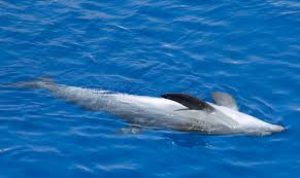
A whole list of factors will cause a dolphin to sink or swim in water, including how much air it has in its body, the amount of blubber it has, and perhaps most importantly, how deep it is in the water. Whether or not an animal floats or sinks in water is a direct result of something called buoyancy. The principle of buoyancy was initially discovered by the famous Greek mathematician Archimedes, who was born in 287 BC. It works like this: when you submerge an object in water, the object will displace a volume of water equal to its own volume. Now, if the water that has been displaced has the exact same mass as the object, the object will stay in one place. But, if the object has less mass than the water that has been displaced, the object will float. The denser water will actually push the object up to the surface. If on the other hand the object has more mass than the displaced water, it will sink. Mass will be determined by the material that the object is made of. If you have an object made up of a very dense material, like steel, then that object will most certainly sink, whereas less dense material, like air, will float.
A dolphin’s body is filled with materials of various densities. Bones, which are denser than muscle. Muscle, which is denser than blubber. But, also air spaces – primarily the lungs. You can total all of these together to get the overall mass of a dolphin. Comparing the dolphin’s mass to the mass of the water that is displaced by the dolphin’s body when submerged will tell you whether or not the dolphin will float or sink. As a general rule, a healthy dolphin with its lungs filled with air will float at the surface: its body has less mass than the seawater it displaces. This is primarily because air is much less dense than seawater, which means a portion of the dolphin’s body volume is filled with a material much less dense than the water around it.
But that’s not the whole story. As a dolphin dives down in the water, another factor comes into play: hydrostatic pressure . This is the weight of the water itself. Water is heavy stuff, and as a dolphin starts to dive under water the increasing weight of the water on top of it will start to affects its body rather drastically. The hydrostatic pressure will cause the dolphin’s lungs to collapse: the air in a dolphin’s body is actually squeezed into a smaller area. At about 65 or 70 meters down, a dolphin’s lungs will be completely collapsed, and the actual size of a dolphin’s body will shrink. Compared to its size at the surface, the dolphin is now physically smaller – much like a sponge that you can crush in your hand into a tiny ball. But despite all this shrinking, the dolphin’s mass stays the same. Since the dolphin is now displacing less water because it has shrunk, but its mass stays the same, it actually starts to become heaver than the water it displaces the deeper it goes. So now the tables have turned and the dolphin will start to sink instead of float. This is something that all deep diving marine mammals use to their advantage when foraging in deep waters. Many species need to counteract their positive buoyancy at the surface by actively swimming down, but once they reach the magic shrinking point, they can relax and glide deeper down without moving a muscle. Not all species of marine mammals are positively buoyant at the surface: a few species of seals as well as some of the great whales are negatively buoyant at the surface. But dolphin species, as far as I have been able to determine, all appear to be positively buoyant at the surface.
Of course, this positive buoyancy assumes that they have lungs filled with air. When a dolphin or whale dies, the air in its body may disappear or even be replaced by water, causing it to sink. A few species of whale and dolphin (including the right whale and the sperm whale) appear to be positively buoyant even when dead, which causes them to float. As time passes, even the body of a dead whale or dolphin that has sunk to the bottom might actually start to float again as the process of decomposition begins creating gasses in its body that cause it to become positively buoyant.
It has also been noted that buoyancy changes depending on how much fat or blubber an animal has on its body. This may change with the season as some migratory species move from breeding grounds to feeding ground and their eating habits change.
Another factor that affects the buoyancy of dolphins while diving is the temperature of the water. In most of the ocean, the water tends to get colder the deeper you go. Colder water is denser than warm water, which means that as a dolphin starts to dive into deep cold waters, the increased density of the cold water will once again begin increasing the dolphin’s buoyancy.
So as you can see, there is no easy answer to the question ‘does a dolphin sink or swim’. But who needs easy answers when you can have interesting ones, right?
Reading Resources:
[ms_audio style=”light” mp3=”https://www.dolphincommunicationproject.org/wp-content/uploads/2022/05/thedolphinpod3sciencespotlight.mp3″ ogg=”” wav=”” mute=”” loop=”” controls=”yes” class=”dcp-embed-mp3″ id=””]
